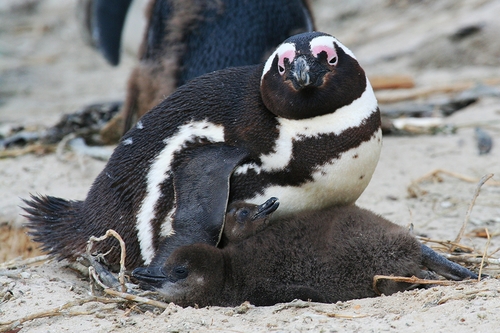
African Penguin
The African Penguin (*Spheniscus demersus*), also known as the Jackass Penguin or Black-footed Penguin, is a species of penguin confined to southern African waters. It is the only penguin species that breeds in Africa. These charismatic birds are instantly recognizable by their black and white plumage and distinctive pink glands above their eyes, which help them cope with temperature changes. African penguins play a vital role in their marine ecosystem as both predator and prey, and have unfortunately experienced drastic population declines, making them a focus of conservation efforts. They were once called Jackass Penguins, due to their loud, donkey-like braying call.
60-70 cm
Length
Not applicable (wings modified into flippers) cm
Wingspan
Endangered
Conservation Status
Distribution
The African Penguin is found along the coast and offshore islands of southern Africa, from Namibia to South Africa. The largest colonies are located on islands off the coast of South Africa.
Lifespan
10-20 years in the wild; up to 25 years in captivity.
African Penguin's Habitat
Habitat Types
Rocky coastlines, Sandy beaches, Offshore islands
Climate Zones
Temperate, Subtropical
Adaptations
African Penguins have several adaptations to their marine environment, including dense, waterproof feathers for insulation, streamlined bodies for efficient swimming, and salt glands to excrete excess salt ingested while feeding at sea. Their countershaded plumage (dark back, light belly) provides camouflage from predators both above and below the water.
Variations
No formally recognized subspecies exist, although there may be subtle genetic variations between different colonies.
Appearance
Breeding Plumage
Plumage is generally consistent year-round, although it can appear duller after molting.
Seasonal Feather Changes
Adults undergo a complete molt annually, replacing all their feathers over a period of a few weeks. During this time, they are unable to enter the water and must fast.
Sex Based Plumage Differences
Minimal sexual dimorphism; males and females have similar plumage. Juveniles have a bluer-grey plumage that lacks the distinctive black and white markings of adults.
Notable Features
Black back and white belly (countershading), Black band across the chest and down the flanks, Pink glands above the eyes, Black facial mask with a white stripe running from the eye to the back of the head
Diet and Feeding
Primary Foods
Small fish (anchovies, sardines, pilchards), Squid, Crustaceans
Foraging Behavior
African Penguins are pursuit divers, using their flippers to propel themselves underwater and their feet to steer. They typically forage in groups, often traveling several kilometers offshore to find food. They can hold their breath for an average of 2.5 minutes and dive to depths of up to 130 meters, though most dives are shallower.
Specializations
Their streamlined bodies and powerful flippers are specializations for underwater hunting. Their tongues and palates are covered in rear-facing spines to help grip slippery prey.
Seasonal Diet Variations
Diet can vary depending on the availability of prey, which can fluctuate seasonally and with changing oceanographic conditions.
Behavior
Social Structure
African Penguins are highly social and breed in large colonies. They are generally monogamous, forming long-term pair bonds.
Communication
Loud, braying calls (hence the name 'Jackass Penguin'), Visual displays (head-waving, flipper-shaking), Mutual preening
Migration
African Penguins are not migratory in the traditional sense, but they may undertake localized movements in response to food availability.
Territorial or Group Behaviors
They defend a small territory around their nest site. Outside of the breeding season, they may form large rafts on the water.
Conservation
Threats
Overfishing of prey species, Oil spills, Habitat destruction and degradation, Climate change (affecting prey availability), Predation by seals, sharks, and gulls, Human disturbance
Protection Programs
Marine Protected Areas, Oil spill response and rehabilitation programs, Artificial nest programs, Fisheries management
Local National Laws
Protected under South African and Namibian law.
Population Trend
Decreasing
Population Estimates
Approximately 13,300 breeding pairs remain as of 2023.
Interesting Facts
They can swim at speeds of up to 20 km/h (12 mph) when hunting.
This allows them to catch fast-moving fish.
The pink glands above their eyes help them regulate their body temperature.
Blood flow to these glands increases when the penguin is hot, allowing heat to dissipate.
African Penguin populations have declined by over 90% since the early 1900s.
This dramatic decline is largely due to human activities.
African Penguin's unique spot patterns are like fingerprints
Researchers use these spot patterns to identify individual penguins.
Faqs about African Penguin
Why are African Penguins endangered?
The main threats are overfishing, which reduces their food supply, and oil spills, which damage their feathers and can poison them. Habitat loss and climate change also play a role.
Can I see African Penguins in the wild?
Yes, there are several locations in South Africa and Namibia where you can observe African Penguins in their natural habitat, such as Boulders Beach and Stony Point in South Africa.
Do African Penguins mate for life?
They generally form long-term pair bonds, but 'divorce' can occur, especially if breeding attempts are unsuccessful.
What is being done to help African Penguins?
Conservation efforts include establishing marine protected areas, managing fisheries, responding to oil spills, and providing artificial nests to improve breeding success.
Copyright @ Nature Style Limited. All Rights Reserved.
 English
English